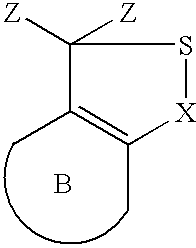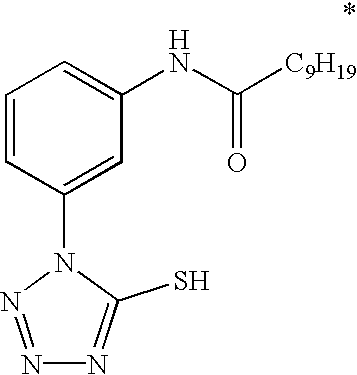Use of direct thermal transparent imaging materials including an organic silver salt for producing labels
- Summary
- Abstract
- Description
- Claims
- Application Information
AI Technical Summary
Benefits of technology
Problems solved by technology
Method used
Image
Examples
invention examples 1 to 11
Preparation of the Thermosensitive Element
The subbed 63 .mu.m thick polyethylene terephthalate support was doctor blade-coated with a composition containing 2-butanone as solvent / dispersing medium so as to obtain thereon, after drying for 1 hour at 50.degree. C., a thermosensitive element with the composition:
Over coating of Thermosensitive Element with a Protective Layer
The above-described thermosensitive element was overcoated with a protective layer with the composition:
Thermographic Printing
The thermographic printer used in these experiments was also a thermal head printer, but had a thermal head with a nominal resistance of 1850 ohms, had 85 .mu.m by 85 .mu.m heating elements, printed with a line time of 11.5 ms and the thermographic material was transported at a process speed of 7.36 mm / s. The number of heating pulses, print head voltages and pulse times were completely variable.
The above-described direct thermal material was printed with a single pulse per line time and at th...
invention examples 12 to 33
Direct Thermal Transparent Imaging Material
The direct thermal transparent imaging material used in the experiments of INVENTION EXAMPLES 12 to 33 was produced by coating the thermosensitive element overcoated with a protective layer used in INVENTION EXAMPLES 1 to 11 and coating the opposite side of the support to that coated with the thermosensitive element and its protective layer sequentially with a 5.5 g / m.sup.2 coating of a white acrylic water-based ink pigmented with titanium dioxide having an optical density of 0.38 and over coating with a white pressure sensitive water-based dispersion to a coating weight of 26 g / m.sup.2, the two layers together having an optical density of 0.65. The second layer was then pressure laminated with the silicone-coated side of 65 g / m.sup.2 glassine-based paper coated with a silicone layer, which acts as a release foil.
Printing with a Thermographic Label-printing Apparatus
The label-printing apparatus used for the printing experiments of COMPARATI...
PUM
| Property | Measurement | Unit |
|---|---|---|
| Time | aaaaa | aaaaa |
| Time | aaaaa | aaaaa |
| Density | aaaaa | aaaaa |
Abstract
Description
Claims
Application Information
 Login to View More
Login to View More - R&D
- Intellectual Property
- Life Sciences
- Materials
- Tech Scout
- Unparalleled Data Quality
- Higher Quality Content
- 60% Fewer Hallucinations
Browse by: Latest US Patents, China's latest patents, Technical Efficacy Thesaurus, Application Domain, Technology Topic, Popular Technical Reports.
© 2025 PatSnap. All rights reserved.Legal|Privacy policy|Modern Slavery Act Transparency Statement|Sitemap|About US| Contact US: help@patsnap.com



